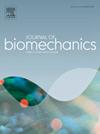应用于短距离行走试验的动力系统理论
IF 2.4
3区 医学
Q3 BIOPHYSICS
引用次数: 0
摘要
人类行走是一项极其复杂的神经肌肉活动,如果试图对这一过程进行定量描述,其简单性将不复存在。动力系统理论为分析动力系统的稳定性和混沌性提供了一个框架,分别采用了 Floquet 乘数(FM)和长期及短期 Lyapunov 指数(LE)。本报告比较了三种方法的 FM 和 LE:方法 A(假近邻和数值近似)、方法 B(假近邻和半分析技术)和方法 C(奇异值分解和半分析技术)。33 名无跌倒史的健康老年人的数据被用来解释动态系统。为分析横向平面的摇摆,计算了代理质心轨迹。结果显示,LE 和 FM 的计算方法存在差异,半分析法更接近观察到的步态行为。方法 A 和 B 的长期 LE 相似,但其他 LE 配对不同。方法 A 的短期 LE 显示所有受试者的步态都是混乱的,而方法 A 和 B 的长期 LE 则显示半数受试者的步态是混乱的。方法 C 显示大多数受试者的步态不混乱。方法 B 的 FM 显示超过 30% 的受试者步态不稳定。方法 C 得出的 LE 值和 FM 值最接近受试者的步态模式。这项研究为使用短时间序列数据进行步态分析提供了方法论基础,有助于深入了解步态动态中的稳定性和混乱性。本文章由计算机程序翻译,如有差异,请以英文原文为准。
Dynamical systems theory applied to short walking trials
Human walking is an extremely complex neuromuscular activity whose simplicity disappears when an attempt is made to provide a quantitative description of the process. The dynamical systems theory provides a framework for analyzing the stability and chaotic nature of dynamical systems, employing Floquet multipliers (FM) and long and short-term Lyapunov exponents (LE), respectively. This report compares FM and LE from three methods: method A (false nearest neighbors and numerical approximation), method B (false nearest neighbors and semi-analytical technique) and method C (singular value decomposition and semi-analytical technique). Data from 33 healthy older adults with no history of falls were used to explain the dynamic system. A surrogate center of mass trajectory was calculated for the analysis of sway in the transverse plane. Results revealed methodological differences in LE and FM calculations with semi-analytical solutions providing closer approximations to observed gait behavior. The long-term LE from Methods A and B were similar, but other LE pairings differed. Method A’s short-term LE indicated chaotic gaits for all subjects, while long-term LE from Methods A and B indicated chaos for half the subjects. Method C showed non-chaotic gait for most subjects. Method B’s FM indicated over 30% of subjects had unstable gait. Method C yielded values of LE and FM that most closely matched the subjects’ gait patterns. This study offers a methodological foundation for gait analysis using short time-series data, facilitating deeper insights into both stability and chaos within gait dynamics.
求助全文
通过发布文献求助,成功后即可免费获取论文全文。
去求助
来源期刊

Journal of biomechanics
生物-工程:生物医学
CiteScore
5.10
自引率
4.20%
发文量
345
审稿时长
1 months
期刊介绍:
The Journal of Biomechanics publishes reports of original and substantial findings using the principles of mechanics to explore biological problems. Analytical, as well as experimental papers may be submitted, and the journal accepts original articles, surveys and perspective articles (usually by Editorial invitation only), book reviews and letters to the Editor. The criteria for acceptance of manuscripts include excellence, novelty, significance, clarity, conciseness and interest to the readership.
Papers published in the journal may cover a wide range of topics in biomechanics, including, but not limited to:
-Fundamental Topics - Biomechanics of the musculoskeletal, cardiovascular, and respiratory systems, mechanics of hard and soft tissues, biofluid mechanics, mechanics of prostheses and implant-tissue interfaces, mechanics of cells.
-Cardiovascular and Respiratory Biomechanics - Mechanics of blood-flow, air-flow, mechanics of the soft tissues, flow-tissue or flow-prosthesis interactions.
-Cell Biomechanics - Biomechanic analyses of cells, membranes and sub-cellular structures; the relationship of the mechanical environment to cell and tissue response.
-Dental Biomechanics - Design and analysis of dental tissues and prostheses, mechanics of chewing.
-Functional Tissue Engineering - The role of biomechanical factors in engineered tissue replacements and regenerative medicine.
-Injury Biomechanics - Mechanics of impact and trauma, dynamics of man-machine interaction.
-Molecular Biomechanics - Mechanical analyses of biomolecules.
-Orthopedic Biomechanics - Mechanics of fracture and fracture fixation, mechanics of implants and implant fixation, mechanics of bones and joints, wear of natural and artificial joints.
-Rehabilitation Biomechanics - Analyses of gait, mechanics of prosthetics and orthotics.
-Sports Biomechanics - Mechanical analyses of sports performance.
 求助内容:
求助内容: 应助结果提醒方式:
应助结果提醒方式:


